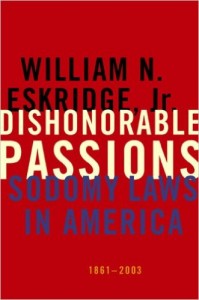 Dishonorable Passions: Sodomy Laws in America, 1861-2003
Dishonorable Passions: Sodomy Laws in America, 1861-2003
by William N. Eskridge Jr.
Viking. 528 pages, $32.95
AMID THE TURMOIL of the French Revolution, one of the little-noticed legal transformations was the axing of ancien régime laws criminalizing “crimes against nature.” The Constituent Assembly of 1789–1791 dropped longstanding (albeit rarely enforced) laws against “sodomy” and “pederasty” in the course of its broad modernization of the penal code in 1791. The revised police code, however, continued to treat “gross public indecency” as a misdemeanor alongside the corruption of minors “of either sex.” Surprisingly, these changes happened without any recorded legislative debate. Legal historians have ascribed this first decriminalization of sodomy to the wave of Enlightenment secularization of law and society. Another factor was a libertarian conviction that the private sphere be protected from state intrusion.
These two legal principles have also been at play in the American revolution in sodomy law—which, unlike France, has taken far longer and left a voluminous paper trail. Yale law professor William Eskridge’s analysis of this history is lengthy and you might need Ritalin to stay focused through the legal details. However, his lively, clear writing is accessible to the general reader, particularly since he sets the legal battles in the wider context of American social history. This is critical since one of his central contentions is that legal change requires societal change which facilitates the intensive, well-calculated legal strategy of civil rights organizations and legal scholars—including himself. Eskridge authored an influential amicus brief challenging sodomy laws for the libertarian Cato Institute.






